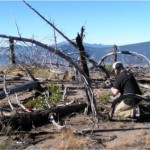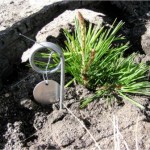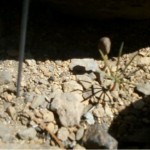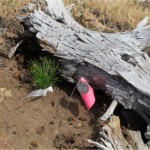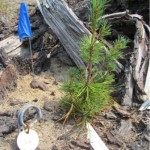2011 Whitebark Rust Validation & Monitoring in Field Planting
Project: Whitebark Rust Validation & Monitoring in Field Planting
Agency/Forest or Park/District: Deschutes National Forest, Central Oregon
Project coordinator: Chris Jensen
Contact: Chris Jensen, Genetics, Deschutes and Ochoco NF 541-383-4779, cejensen@fs.fed.us
Cooperators
Richard Sniezko, Center Geneticist, Dorena Genetic Resource Center (541) 767-5716 rsniezko@fs.fed.us; Angelia Kegley, Geneticist, Dorena Genetic Resource Center (541) 767-5703 akegley@fs.fed.us; Jim Hamlin, R6 Area Geneticist, 541-957-3374 jhamlin@fs.fed.us; Dorena Genetic Resource Center, 34963 Shoreview road, Cottage Grove, OR 97424; Matt Horning, Eastern Oregon Area Geneticist, Deschutes NF (541) 383-5519 mhorning@fs.fed.us, Heather Lintz, Oregon Climate Change Research Institute, 326 Strand Ag Hall, Oregon State University, Corvallis, Oregon, Phone: 541-206-3306; lintzh@science.oregonstate.edu
Source of funding /amount
FHP: $6,300
Supplemental funding:This project received additional support of $5,000 from NFFV and RTRT (50% each).
Dates of restoration efforts
This project was implemented in October 2011.
Objectives
These seedling planting plots were established with multiple objectives for the purposes of 1) validating rust resistance (and susceptibility) from early juvenile screening results with long- term field results; 2) evaluate genetic variation in growth, form, damage and survival; 3) evaluate adjacent micro-site structures and environments surrounding each planted seedling to help determine the most favorable for growth and survival.
Additional objectives include:
- Enhance the numbers of living whitebark pine on a degraded landscape and to deploy putatively resistant genotypes into the environment;
- Compare success rates of planting seedlings vrs. directly planting seed (caches);
- Compare survival, establishment rates, and performance of stock types grown at different facilities (CDA vrs DGRC)
Acres/ha treated
10 acres
Methods
- A total of 5 permanent seedling and seed cache planting plots were established on 5 mountain-top sites on the Deschutes National forest. These sites were estimated to be favorable for seedling survival and establishment and represented a realistic restoration setting in different aspects and environments. Seedlings were planted variably based on micro-structure availability and the best planting spots on-hand rather than systematically spaced plots. Each plot consists of an average 200 seedlings along with 35 (3 seed per hole) caches that cover approximately 2 acres each. A total of 955 seedlings and 188 seed caches are in monitoring and evaluation status.
- These seedlings originated from 17 central Oregon (Deschutes National Forest and Crater Lake National Park) parent trees screening for blister rust resistance at Dorena Genetic Resource Center. Based on 2007 sowing year data, 14 families show putative resistance to white pine blister rust (wpbr) , with 3 families show high levels of susceptibility. The seedlings were grown as 2 year S10-D stock at two separate facilities – Dorena GRC and Coeur d’Alene nursery. Nursery origins were recorded and monitored to compare short term establishment effects from differing nurseries.
- The seed used in the seed caches were all utilized from a common bulked lot of DES origin select trees. Seed was not stratified in this project.
Summary of Monitoring (2 years after planting)
All plots were monitoring summer of 2013 two years after planting. These two establishment years are critical, however, additional time and monitoring are necessary for stronger evaluations and results.
Plot survivals ranged widely, from a high of 98% to a low of 28% (mean 62%). Pocket gophers were the primary cause of mortality followed by climatic damage caused from unseasonably dry post-planting conditions. This environmental condition resulting in winter desiccation damage and mortality was more pronounced on the south aspect sites.
Survival by Aspect: Aside from the post-planting damage, there was apredictable trend of poorer survival on the drier, southern aspects and higher survival on western and northern aspects.
| Acc | Source | Rust Resist. Rating | N | 2 Yr Surv |
| 011050 | DES | F | 55 | 75% |
| 011073 | DES | A | 55 | 67% |
| 011074 | DES | B | 51 | 67% |
| 011079 | DES | A | 46 | 70% |
| 011080 | DES | F | 55 | 71% |
| 011081 | DES | A | 58 | 60% |
| 011083 | DES | A | 41 | 83% |
| 011085 | DES | B | 57 | 72% |
| 011086 | DES | C | 57 | 68% |
| 011087 | DES | C | 60 | 74% |
| 011088 | DES | A | 57 | 57% |
| 011089 | DES | C | 57 | 42% |
| 011090 | DES | A | 57 | 61% |
| 011091 | DES | A | 59 | 67% |
| 011095 | DES | A | 59 | 66% |
| 136207 | CLNP | C | 37 | 73% |
| 136211 | CLNP | D | 40 | 80% |
Family survival differences are presented in figure 3, ranging from a high of 83% to a low of 42%. Evaluating family survivals is pre-mature at this early age given the range of environmental variables and possible latent nursery effects on the seedlings.
Differing nursery stock comparisons:
There were considerable seedling size, vigor and root mass differences between the seedlings grown at the two separate nurseries. Initial height and vigor data was collected on each seedling at time of planting.
Overall, the DGRC stock had a 12% (mean) height advantage, higher survival (73%) and generally more robust appearance than the CDA stock (64% survival) as indicated in figure 4. The DGRC stock also had a higher number of vigorously appearing seedlings rated and recorded during initial data collection.
It remains unclear if bigger is better in these harsh planting environments; however, early two-year data trends favorably towards the larger stock having higher survival rates.
Micro-site interactions:
Figure 5 shows mean survivals by structure type, and corresponding survivals by distance from the structure. Planting adjacent to woody material appears favorable over rock as indicated by this early year 2 data.
Rock, particularly on southern aspects, may be less favorable to seedling establishment.
No single structure type significantly stands out at this point; however, seedlings planted inside a distance of 15 inches predictably have an increased survival trend presumably from shading effects.
Surprisingly, open-planted seedlings without any adjacent structures experienced only slightly less survival than micro-site planted seedlings.
Additional evaluation over time is necessary to make any strong or significant conclusions or recommendations on micro-site interactions. This comparison is fraught with environmental variables, but some significant trends may appear over time.
Direct Seeding Germination Success:
Evaluating direct seed planting was integrated into this project to compare the success of planting seedlings with directly planting seeds as a restoration tool in a natural field setting.
Multi-seed caches (3 seeds per hole) were planted randomly throughout each plot utilizing similar micro-site structures common to the seedlings. This seed was not stratified, nor were protective cages installed over the caches.
Germination success of the caches was very disappointing in this project, and functionally a failure. A total of 6 live germinates (2 year) were recorded out of a total of 198 caches (approximately 36 caches per plot) with a combined total of 594 seeds. All live germinates are located in a single plot with no apparent explanation. Because the seed experienced two natural stratification periods, germination should have peaked in 2013. Seed caches were not monitored after 1 year, and presumably, some germination went un-recorded and died. It is unknown why such poor germination occurred, but observations indicate seed predation was high, with many small excavations and depressions present at cache location presumably caused by foraging rodents.
An earlier (2007) direct seed planting pilot project on the Deschutes NF (at Mt. Bachelor Ski Area) resulted in good seed germination. Stratified seed that was protected experienced 75% germination. Seed that received no stratification and no protection had much less germination (25%). In each case, if the seed was not protected with wire mesh cages, predation from unknown agents (presumably rodents) was high.
Dates/Plans for future monitoring?
Seedling plots will continue to have monitoring performed on a two to four year basis. Funding sources are unknown at this point. Long-term monitoring will be necessary to validate rust resistance, genetic variation, and micro-site interactions.
Will outcome meet goals?
Goals as outlined in the proposal will be met. A more thorough summary paper detailing the findings of the project is currently being finalized and will be forwarded when complete.
Miscellaneous comments
Results from this project should help develop planting guidelines in environments common to the Pacific Northwest and the Cascades Range. Partial monitoring of the plots was completed by Mai Duong and Matt Mcintosh, OSU under-grad student interns.
